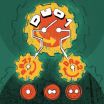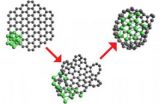(Press-News.org) Atomic-scale snapshots of a bimetallic nanoparticle catalyst in action have provided insights that could help improve the industrial process by which fuels and chemicals are synthesized from natural gas, coal or plant biomass. A multi-national lab collaboration led by researchers with the U.S. Department of Energy (DOE)'s Lawrence Berkeley National Laboratory (Berkeley Lab) has taken the most detailed look ever at the evolution of platinum/cobalt bimetallic nanoparticles during reactions in oxygen and hydrogen gases.
"Using in situ aberration-corrected transmission electron microscopy (TEM), we found that during the oxidation reaction, cobalt atoms migrate to the nanoparticle surface, forming a cobalt oxide epitaxial film, like water on oil," says Haimei Zheng, a staff scientist in Berkeley Lab's Materials Sciences Division who led this study. "During the hydrogen reduction reaction, cobalt atoms migrate back into the bulk, leaving a monolayer of platinum on the surface. This atomic information provides an important reference point for designing and engineering better bimetallic catalysts in the future."
Zheng, a 2011 recipient of a DOE Office of Science Early Career Award, is the corresponding author of a paper describing this research in the journal NANO Letters entitled "Revealing the Atomic Restructuring of Pt-Co Nanoparticles." Co-authors at Berkeley are Huolin Xin, Selim Alayoglu, Runzhe Tao, Lin-Wang Wang, Miquel Salmeron and Gabor Somorjai. Other co-authors are Chong-Min Wang and Libor Kovarik, of the Pacific Northwest National Laboratory (PNNL), Eric Stach of Brookhaven National Laboratory (BNL), and Arda Genc of the FEI Company in Oregon.
Bimetallic catalysts are drawing considerable attention from the chemical industry these days because in many cases they offer superior performances to their monometallic counterparts. There is also the possibility of tuning their catalytic performances to meet specific needs. A bimetallic catalyst of particular interest entails the pairing of platinum, the gold standard of monometallic catalysts, with cobalt, a lesser catalyst but one that is dramatically cheaper than platinum. The platinum/cobalt catalyst is not only considered a model system for the study of other bimetallic nanocatalysts, it is also an excellent promoter of the Fischer-Tropsch process, in which mixtures of hydrogen and carbon monoxide are converted into long-chain carbons for use as fuels or in low-temperature fuel cells.
"While there have been many studies on platinum/cobalt and other bimetallic catalysts, information on how reactions proceed atomically and what the morphology looks like has been missing," Zheng says. "To acquire this information it was necessary to map the atomic structures in reactive environments in situ, which we did using specially equipped TEMs."
The in situ environmental TEM experiments were carried out at both the Environmental Molecular Sciences Laboratory, which is located at PNNL, and at BNL's Center for Functional Nanomaterials. Ex situ aberration-corrected TEM imaging was done at Berkeley Lab's National Center for Electron Microscopy using TEAM 0.5, the world's most powerful TEM.
"This work is an excellent example of collaborative team-work among multiple institutes," Zheng says. "Having access to such high-end resources and being able to form such close team collaborations strengthens our ability to tackle challenging scientific problems."
The in situ aberration corrected TEM studies of Zheng and her colleagues revealed that because of a size mismatch between the lattices of the cobalt oxide epitaxial film and the platinum surface, the cobalt oxide lattice is compressively strained at the interface to fit on the platinum lattice. As the strain energy relaxes, the cobalt oxide film starts breaking up to form distinct molecular islands on the platinum surface. This reduces the effective reaction surface area per volume and creates catalytic voids, both of which impact overall catalytic performance.
"By taking this segregation of the platinum and cobalt atoms into consideration, the interfacial strain that arises during oxidation can be predicted," Zheng says. "We can then design nanoparticle catalysts to ensure that during reactions the material with higher catalytic performance will be on surface of the nanoparticles."
Zheng adds that the ability to observe atomic scale details of the evolution of the structure of nanoparticles in their reactive environments not only opens the way to a deeper understanding of bimetallic nanoparticle catalysis, it also allows for the study of a wider variety of nanoparticle systems where reaction pathways remain elusive.
INFORMATION:
This research was supported by the DOE Office of Science The research made use of the Environmental Molecular Sciences Laboratory, BNL's Center for Functional Nanomaterials, and Berkeley Lab's National Center for Electron Microscope, user facilities also supported by DOE's Office of Science.
Lawrence Berkeley National Laboratory addresses the world's most urgent scientific challenges by advancing sustainable energy, protecting human health, creating new materials, and revealing the origin and fate of the universe. Founded in 1931, Berkeley Lab's scientific expertise has been recognized with 13 Nobel prizes. The University of California manages Berkeley Lab for the U.S. Department of Energy's Office of Science. For more, visit http://www.lbl.gov.
The U.S. Department of Energy's Office of Science, the single largest supporter of basic research in the physical sciences in the United States, is working to address some of the most pressing challenges of our time. For more information, please visit science.energy.gov.
Evolution of a bimetallic nanocatalyst
National lab collaboration takes atomic-scale look at platinum/cobalt nanoparticle catalysts
2014-06-06
ELSE PRESS RELEASES FROM THIS DATE:
Tougher penalties credited for fewer casualties among young male drivers
2014-06-06
VIDEO:
A new Western University study led by Dr. Evelyn Vingilis has found a significant decline in speeding-related fatalities and injuries among young men in Ontario since the province's tough extreme...
Click here for more information.
A new study out of Western University (London, Canada) has found a significant decline in speeding-related fatalities and injuries among young men in Ontario since the province's tough extreme speeding and aggressive driving laws were introduced ...
Endoscope with an oxygen sensor detects pancreatic cancer
2014-06-06
JACKSONVILLE, Fla. — June 6, 3014 — An optical blood oxygen sensor attached to an endoscope is able to identify pancreatic cancer in patients via a simple lendoscopic procedure, according to researchers at Mayo Clinic in Florida.
The study, published in GIE: Gastrointestinal Endoscopy, shows that the device, which acts like the well-known clothespin-type finger clip used to measure blood oxygen in patients, has a sensitivity of 92 percent and a specificity of 86 percent.
MULTIMEDIA ALERT: Video and audio are available for download on the Mayo Clinic News Network.
That ...
Magnetic moment of the proton measured with unprecedented precision
2014-06-06
One of the biggest riddles in physics is the apparent imbalance between matter and antimatter in our universe. To date, there is no explanation as to why matter and antimatter failed to completely annihilate one another immediately after the big bang and how the surplus matter was created that went on to form the universe as we know it. Experiments conducted at Johannes Gutenberg University Mainz (JGU) have contributed towards a resolution of this problem. For the first time a direct and high-precision measurement of the magnetic moment of the proton has been conducted ...
A new way to make laser-like beams using 250x less power
2014-06-06
ANN ARBOR – With precarious particles called polaritons that straddle the worlds of light and matter, University of Michigan researchers have demonstrated a new, practical and potentially more efficient way to make a coherent laser-like beam.
They have made what's believed to be the first polariton laser that is fueled by electrical current as opposed to light, and also works at room temperature, rather than way below zero.
Those attributes make the device the most real-world ready of the handful of polariton lasers ever developed. It represents a milestone like none ...
New species of ancient chirping giant pill-millipedes from Madagascar already threatened
2014-06-06
An international team of researchers comprised of Thomas Wesener, Museum Koenig, Bonn, Daniel Le, Field Museum, Chicago and Stephanie Loria, American Museum of Natural History, New York, discovered seven new species of chirping giant pill-millipedes on Madagascar. The study was published in the open access journal ZooKeys.
The species discovered all belong to the genus Sphaeromimus, which is Latin for 'small ball animal'. However, the designation 'small' is not always true for the members of the genus as one of the newly discovered species surprises with a size larger ...
Probiotics prevent deadly complications of liver disease
2014-06-06
Bethesda, MD (June 6, 2014) — Probiotics are effective in preventing hepatic encephalopathy in patients with cirrhosis of the liver, according to a new study in Clinical Gastroenterology and Hepatology, the official clinical practice journal of the American Gastroenterological Association. Hepatic encephalopathy is a deterioration of brain function that is a serious complication of liver disease.
"This rigorous new research finds that probiotics modify the gut microbiota to prevent hepatic encephalopathy in patients with cirrhosis of the liver," said David W. Victor III, ...
Shatterproof screens that save smartphones
2014-06-06
University of Akron polymer scientists have developed a transparent electrode that could change the face of smartphones, literally, by making their displays shatterproof.
In a recently published scientific paper, researchers demonstrated how a transparent layer of electrodes on a polymer surface could be extraordinarily tough and flexible, withstanding repeated scotch tape peeling and bending tests. This could revolutionize and replace conventional touchscreens, according to Yu Zhu, UA assistant professor of polymer science. Currently used coatings made of indium tin ...
Breakthrough study solves plant sex mystery
2014-06-06
A team of biologists from the University of Leicester has solved a mystery surrounding how plants have sex.
The researchers have discovered a pair of proteins made by flowering plants that are vital for the production of the sperm present within each pollen grain.
Scientists already knew that flowering plants, in contrast to animals, require not one, but two sperm cells for successful fertilisation: one to join with the egg cell to produce the embryo and one to join with a second cell to produce the nutrient-rich endosperm inside the seed.
The mystery of this 'double ...
Method of nickel-carbon heterofullerenes synthesis presented
2014-06-06
Scientists from several British, Spanish and Russian research centers (MIPT, Institute for Spectroscopy RAS, Kurchatov Institute and Kintech Lab Ltd) have come up with a method of synthesizing a new type of nickel-carbon compound. The article titled Formation of nickel-carbon heterofullerenes under electron irradiation has been published by Dalton Transactions and is available as a pre-print at arxiv.org. The first author of the article is Alexander Sinitsa, an MIPT student, and the leading author is Andrey Popov (Institute for Spectroscopy RAS, 1989 MIPT graduate).
Heterofullerenes ...
Mitochondrial DNA of first Near Eastern farmers is sequenced for the first time
2014-06-06
The mitochondrial DNA of the first Near Eastern farmers has been sequenced for the first time. In the research, published in the journal PLOS Genetics, experts analysed samples from three sites located in the birthplace of Neolithic agricultural practices: the Middle Euphrates basin and the oasis of Damascus, located in today's Syria and date at about 8,000 BC.
The paper is signed by Daniel Turbón and Alejandro Pérez Pérez, from the Department of Animal Biology of the University of Barcelona (UB); Eva Fernández, from Liverpool John Moores University; Cristina Gamba, Eduardo ...
LAST 30 PRESS RELEASES:
University of Oklahoma researcher awarded funding to pursue AI-powered material design
Exploring how the visual system recovers following injury
Support for parents with infants at pediatric check-ups leads to better reading and math skills in elementary school
Kids’ behavioral health is a growing share of family health costs
Day & night: Cancer disrupts the brain’s natural rhythm
COVID-19 vaccination significantly reduces risk to pregnant women and baby
The role of vaccination in maternal and perinatal outcomes associated with COVID-19 in pregnancy
Mayo Clinic smartwatch system helps parents shorten and defuse children's severe tantrums early
Behavioral health spending spikes to 40% of all children’s health expenditures, nearly doubling in a decade
Digital cognitive behavioral treatment for generalized anxiety disorder
Expenditures for pediatric behavioral health care over time and estimated family financial burden
Air conditioning in nursing homes and mortality during extreme heat
The Alps to lose a record number of glaciers in the next decade
What makes a good proton conductor?
New science reporting guide published for journalists in Bulgaria
New international study reveals major survival gaps among children with cancer
New science reporting guide published for journalists in Turkey
Scientists develop a smarter mRNA therapy that knows which cells to target
Neuroanatomy-informed brain–machine hybrid intelligence for robust acoustic target detection
Eight SwRI hydrogen projects funded by ENERGYWERX
The Lundquist Institute and its start-up company Vitalex Biosciences Announces Strategic Advancement of Second-Generation fungal Vaccine VXV-01 through Phase 1 Trials under $40 Million Competitive Con
Fine particles in pollution are associated with early signs of autoimmune disease
Review article | Towards a Global Ground-Based Earth Observatory (GGBEO): Leveraging existing systems and networks
Penn and UMich create world’s smallest programmable, autonomous robots
Cleveland researchers launch first major study to address ‘hidden performance killer’ in athletes
To connect across politics, try saying what you oppose
Modulating key interaction prevents virus from entering cells
Project explores barriers to NHS career progression facing international medical graduates
Jeonbuk National University researchers explore the impact of different seasonings on the flavor perception of Doenjang soup
Two Keck Medicine of USC Hospitals named Leapfrog Top Teaching Hospitals
[Press-News.org] Evolution of a bimetallic nanocatalystNational lab collaboration takes atomic-scale look at platinum/cobalt nanoparticle catalysts








